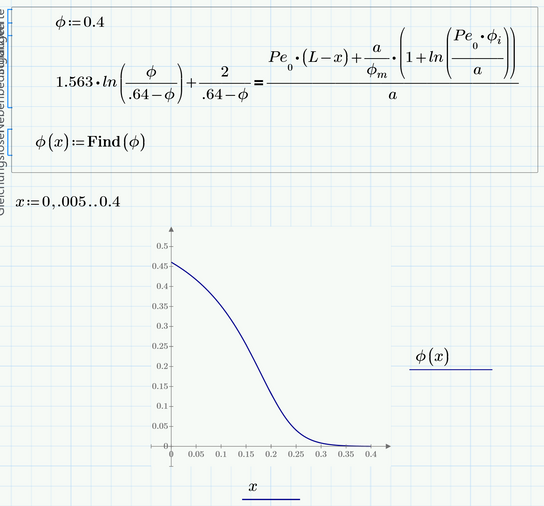- Subscribe to RSS Feed
- Mark Topic as New
- Mark Topic as Read
- Float this Topic for Current User
- Bookmark
- Subscribe
- Mute
- Printer Friendly Page
Help needed in obtaining steady state volume fraction profile
- Mark as New
- Bookmark
- Subscribe
- Mute
- Subscribe to RSS Feed
- Permalink
- Notify Moderator
Help needed in obtaining steady state volume fraction profile
Hi,
I need to solve this equation to get an expression for volume fraction, phi (x). For the given constants, phi (x) vs x should look similar to that in figure. Kindly check attachment. I tried to solve it symbolically but it keeps showing an error.
Regards
Solved! Go to Solution.
- Labels:
-
Calculus_Derivatives
Accepted Solutions
- Mark as New
- Bookmark
- Subscribe
- Mute
- Subscribe to RSS Feed
- Permalink
- Notify Moderator
.) Don't use and define a range for the independent variable x in front of the calculation- Just use it for plotting.
.) You can't solve for a function, so use just Phi and not Phi(x)
.) There is no closed analytic solution to your equation. That means that the symbolic solver is useless here. Just use the numeric solver and turn the solve block into a function of x as shown below:
- Mark as New
- Bookmark
- Subscribe
- Mute
- Subscribe to RSS Feed
- Permalink
- Notify Moderator
.) Don't use and define a range for the independent variable x in front of the calculation- Just use it for plotting.
.) You can't solve for a function, so use just Phi and not Phi(x)
.) There is no closed analytic solution to your equation. That means that the symbolic solver is useless here. Just use the numeric solver and turn the solve block into a function of x as shown below:
- Mark as New
- Bookmark
- Subscribe
- Mute
- Subscribe to RSS Feed
- Permalink
- Notify Moderator
Hi,
Thanks a lot Werner. I have one more question. This solution is at steady state (t= infinity). To understand phi (x,t) vs x for different time t, one needs to integrate the expression (please check pg 2 of mathcad file). Could you please tell me how to go about doing it?
Regards
- Mark as New
- Bookmark
- Subscribe
- Mute
- Subscribe to RSS Feed
- Permalink
- Notify Moderator
Obviously a partial DE. But you are using Phi as variable as well as as function of x and t. You should clear this situation before you go on.
- Mark as New
- Bookmark
- Subscribe
- Mute
- Subscribe to RSS Feed
- Permalink
- Notify Moderator
Hi Werner,
If you keep it as a variable, how would you proceed? The equation from the paper is shown in the attachment..
Regards
- Mark as New
- Bookmark
- Subscribe
- Mute
- Subscribe to RSS Feed
- Permalink
- Notify Moderator
@arnair81 wrote:
Hi Werner,
If you keep it as a variable, how would you proceed? The equation from the paper is shown in the attachment..
Regards
If Phi is taken as variable it would not make much sense to take any derivative of Phi is this would be zero. So this is sure not what was meant in your paper.
I remember a similar discussion here in the forum a short time ago...
- Mark as New
- Bookmark
- Subscribe
- Mute
- Subscribe to RSS Feed
- Permalink
- Notify Moderator
Hi Werner,
That was me as well :-). I tried to solve a pde using numol. Luc helped me but the resulting plot in mathcad 15 was not accurate. Volume fraction went below 0 because the boundary conditions could not be properly defined. The equation here a slightly different. I have modified the mathcad sheet. If you can help me solve this, it would be great.
Regards
- Mark as New
- Bookmark
- Subscribe
- Mute
- Subscribe to RSS Feed
- Permalink
- Notify Moderator
I fear I can't be of much help with this.
My experience with pdesolve or numol is almost nonexistent and I am not really sure about the meaning of your PDE in this sheet.
- Mark as New
- Bookmark
- Subscribe
- Mute
- Subscribe to RSS Feed
- Permalink
- Notify Moderator
Thanks Werner. There isn't much discussion about numol over here. I tried searching for it and I couldn't find any. My problem is that I am not sure how to give the boundary and initial conditions in this case. I hit a brick wall every time I try. Let me know if you have any material that can point me in the right direction.
Regards



